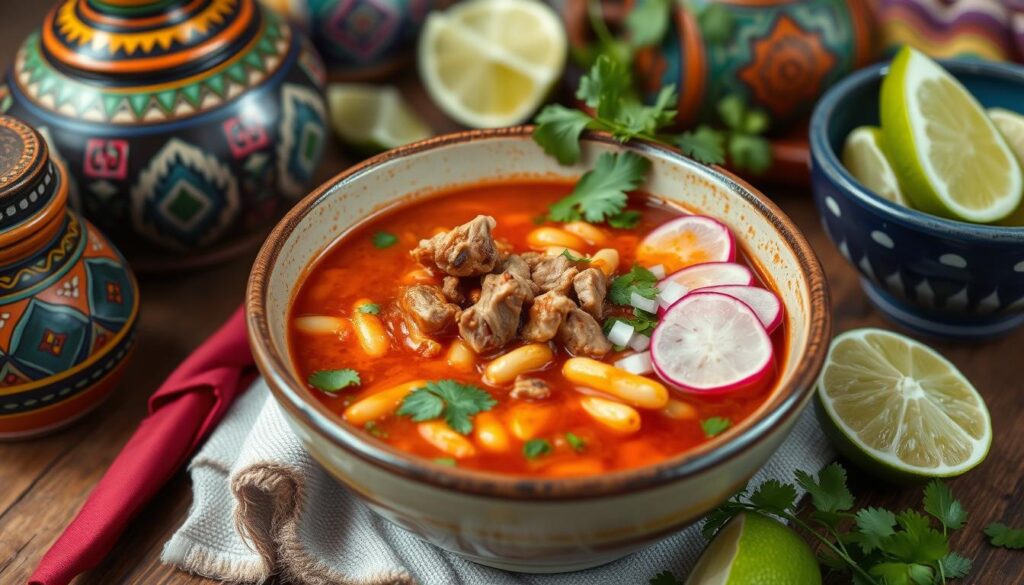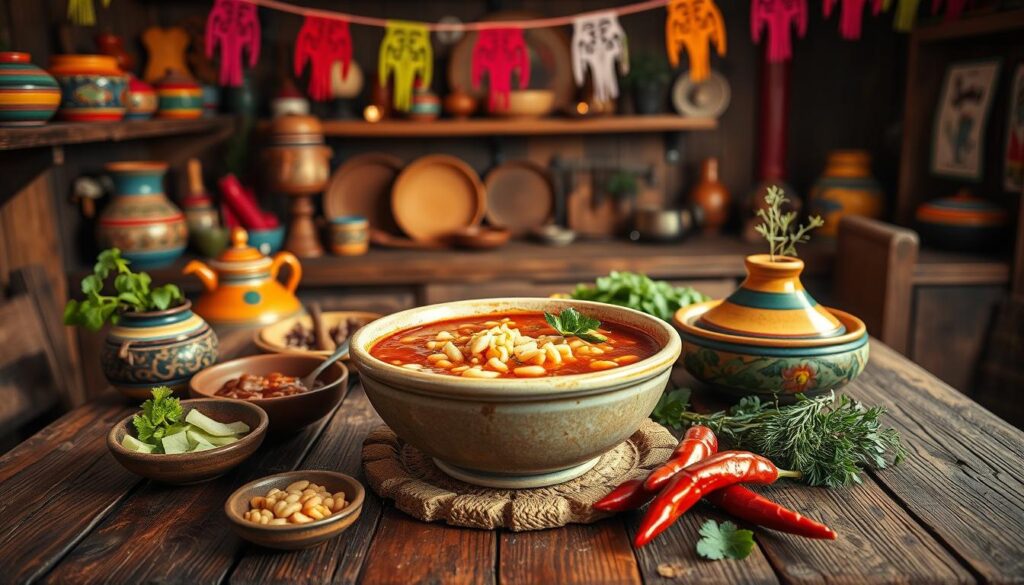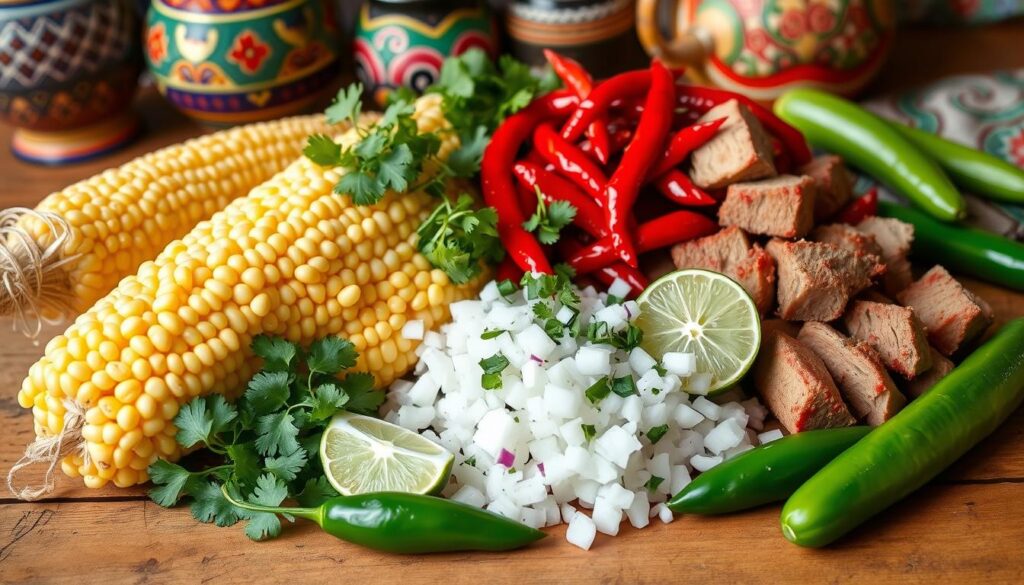Winter evenings in your childhood were cozy, filled with warmth and smells from the kitchen. Your grandmother would put on her apron, ready to make her famous posole rojo. The stew simmered, blending pork and dried chiles into a delicious mix.
This was more than just dinner; it was a time to celebrate family and culture. Everyone would gather, enjoying creamy hominy and vibrant toppings. Laughter filled the room, showing the power of community.
Try this authentic Mexican Posole Rojo recipe to feel the warmth and comfort it brings. It’s perfect for any special occasion. For the full guide, visit here.

Table of Contents
Key Takeaways
- Authentic posole rojo is packed with tender pork and hominy, making it a comforting dish.
- Dried chiles like guajillo and ancho add a vibrant red hue and mild to medium heat.
- The recipe includes versatile ingredients, allowing substitutions such as beef for pork.
- Traditional toppings enhance the flavor and experience of the stew.
- Posole can be enjoyed year-round, especially during holidays and family gatherings.
- Convenience options, like canned hominy, simplify preparation without sacrificing flavor.
Introduction to Posole Rojo
Posole rojo is a vibrant part of Mexican cuisine, filled with rich flavors and cultural history. It’s a hearty Mexican stew that brings people together, especially during Christmas Eve. It’s a time for family and friends to share meals and make memories.

Posole rojo is made with authentic ingredients. It uses guajillo and ancho chiles for depth and aroma. You can also try pozole verde for a different taste, but it keeps the dish’s essence.
The recipe for posole rojo includes 2 pounds of pork and 3 (15-ounce) cans of hominy. It takes hours to cook, but it’s worth it. Posole rojo is perfect for cozy nights or special holidays, warming both the body and spirit.
What is Posole?
Posole, also known as Mexican pozole, is a traditional Mexican stew. It uses hominy, which is dried corn treated with lye. This gives posole its unique chewy texture and pairs well with the flavorful broth.
The broth is made with pork shoulder, adding richness to the dish. Posole is known for its comforting warmth. It comes in three styles: blanco (white), verde (green), and rojo (red).
The flavor of posole rojo is special, thanks to California, guajillo, and ancho chiles. These chiles add depth without making the soup too spicy. Making posole rojo takes about 15 minutes to prepare and three hours to cook.
It serves six to eight people, perfect for family meals. The dish is garnished with limes, onions, crema, and avocados. This lets everyone add their favorite toppings.
Some like to add chiles de arbol or fish sauce for extra heat. Posole is more than just a meal; it’s a part of Mexican culture. It’s served at special occasions and holiday feasts.

History and Cultural Significance of Posole
The history of posole is fascinating and deeply rooted in ancient Mesoamerican cultures, especially the Aztecs. The name posole comes from the Nahuatl word pozolli, meaning a stew of maize kernels. It was a dish for the Aztec elite, enjoyed during special times like god celebrations, harvests, and seasonal changes.
The Aztecs’ culinary traditions made posole a big part of Mexican culture. They even used it in rituals, including human sacrifices, to honor their gods. After the Spanish conquest, pork became the main meat in posole, replacing human flesh.
As early as 1529, a Spanish Franciscan missionary wrote about posole. Over time, it has changed but still holds its place as a beloved Mexican dish. Its old forms used white cacahuazintle corn with various proteins. Today, it can have different meats, seafood, or even vegetarian options, but its roots stay the same.

There are many regional posole types, like Pozole Rojo, Verde, and de Mariscos. These show how versatile posole is across Mexico. They keep the dish’s spirit alive while letting families make their own special recipes. Sharing posole brings people together, strengthening family and community bonds.
| Aspect | Details |
|---|---|
| Origin | Derived from the Aztec dish, meaning ‘stew of maize kernels’ |
| Historical Context | Initially a meal for elite Aztecs served during rituals |
| Cultural Importance | Symbolizes gatherings and connections among communities |
| Evolution | Shifted from human sacrifices to modern meat choices |
| Contemporary Variations | Pozole Rojo, Pozole Verde, and various modern adaptations |
Key Ingredients for Authentic Posole Rojo
To make a real Posole Rojo, focus on a few key ingredients. These not only add great flavor but also keep the dish true to its Mexican roots. Let’s look at the main parts that make up this hearty stew.
Pork Shoulder: The Star of the Dish
Pork shoulder is the heart of Posole Rojo. It’s known for its rich marbling, which makes it tender and flavorful when slow-cooked. The pork’s tender texture makes the soup even better.
While other cuts can work, pork shoulder is unmatched in taste and texture.
Dried Chiles: Guajillo and Ancho
Dried chiles are crucial for Posole Rojo’s deep red color and bold flavor. Guajillo and ancho chiles are the perfect mix. Guajillo chiles bring a sweet and smoky taste, while ancho chiles add a mild yet complex flavor.
This mix is what makes the broth of your dish truly authentic.
Canned Hominy: A Convenient Option
While traditional posole uses dried hominy, canned hominy is a great alternative. It’s pre-cooked, making it easy to use without losing flavor. It adds a hearty texture that goes well with the pork and chiles.

| Ingredient | Description | Notes |
|---|---|---|
| Pork Shoulder | Richly marbled, tender, and juicy | Best for slow cooking for ultimate tenderness |
| Guajillo Chiles | Sweet and smoky flavor | Popular choice for authentic Posole Rojo |
| Ancho Chiles | Mild heat with fruity undertones | Essential for complexity in the broth |
| Canned Hominy | Pre-cooked, convenient, and flavorful | Can substitute for dried hominy with ease |
How to Make Posole Rojo
Starting your posole rojo journey is exciting. First, prepare your ingredients well. Each step is key to blending flavors perfectly.
Preparation Steps for the Ingredients
First, collect these ingredients:
- 4 ounces of dried guajillo or ancho chiles
- 3 pounds of pork shoulder (with bone)
- 1 large can of white hominy
- 8 cloves of garlic
- 3 bay leaves
- Ground cumin and dry oregano
- Optional garnishes: cabbage, cilantro, white onion, avocados, limes, red radishes, tostada shells
Start by soaking the dried chiles in boiling water until they soften. Cut the pork shoulder into chunks and brown them in a large pot. This step adds flavor. Also, chop onions finely and mince garlic.
Cooking Process: Step-by-Step
The cooking steps are crucial:
- Boil 5 quarts of water in a large pot.
- Brown the pork chunks for a few minutes, creating a rich flavor base.
- Add the sautéed onions and garlic to the pot.
- Simmer the mixture with spices for approximately 15 minutes.
- In a blender, create a red sauce by combining the soaked chiles and garlic, then strain it to remove any solids.
- Pour the strained red sauce into the pot along with the hominy.
- Let the stew simmer for 2 to 3 hours, until the pork becomes tender, ensuring the flavors meld together.
The final dish should be brothy. It’s ready to be garnished with shredded cabbage, radishes, avocado, and lime wedges. Tostadas are a great side to enjoy with the rich flavors of your posole.
Exploring Traditional Posole Toppings
To make your Posole Rojo even better, try different toppings. These toppings add freshness and a nice contrast to the stew’s rich broth. You can pick from many options to suit your taste.
Vegetable Garnishes
Vegetable garnishes add a nice crunch to your posole. Here are some popular choices:
- Shredded Napa cabbage
- Diced onions
- Sliced radishes
- Chopped fresh cilantro
- Lime wedges
These toppings bring a lively contrast and enhance the stew’s flavors.
Cheese and Cream Options
For extra richness, add cheese and cream to your posole. Here are the top picks:
- Cotija cheese: It’s crumbly and salty, adding depth to the soup.
- Crema mexicana: This creamy topping smooths out the spices in the posole.
With the right toppings, your Posole Rojo will look great and taste amazing.
Variations of Posole: Posole Verde and Other Styles
Exploring posole variations reveals unique ingredients and flavors. Posole verde stands out with its bright green color from tomatillos and green chiles. It comes from Guerrero, a coastal Mexican state, adding a tangy and spicy twist.
Posole verde uses serrano, jalapeño, and poblano chiles. It can be made with pork or chicken. For a lighter choice, a vegetarian version uses vegetable broth and beans. Hominy is the base, giving a satisfying texture.
Posole rojo, found in Mexico City, has a deep red color from red chilies. It offers a rich, savory taste. Fatty pork pieces make the broth even richer.
Pozole blanco is mild and chili-free. It’s great for vegetarians, focusing on meat or vegetable flavors. This version is lighter overall.
Garnishes can make each posole version special. For example, avocado, lettuce, and tortilla chips are perfect with pozole rojo. Posole verde is great with shredded cabbage, radish, cotija cheese, and lime wedges.
| Style of Pozole | Main Ingredients | Characteristics | Common Garnishes |
|---|---|---|---|
| Posole Verde | Tomatillos, green chiles, pork or chicken | Vibrant green color, tangy flavor | Shredded cabbage, radish, avocados |
| Posole Rojo | Red chiles, pork cuts | Deep red color, robust flavor | Avocado, cilantro, tortilla chips |
| Posole Blanco | Meat or vegetables, no chile sauce | Mild taste, lighter option | Varies by preference |
Posole Rojo: A Hearty Winter Stew
Posole rojo is a hearty choice for winter. Its rich flavors, combined with sides, make for a great meal. Serve it with warm corn tortillas or tostadas for a cozy meal.
Perfect Pairings and Serving Suggestions
Choosing the right sides can make your posole experience unforgettable. Here are some ideas to enhance your meal:
- Mexican Rice: It complements the soup’s savory taste well.
- Avocado: Its creamy texture and spice balance are perfect.
- Lime Wedges: A squeeze of fresh lime brightens the dish.
- Sour Cream: It adds richness and cools down the heat.
- Fresh Cilantro: Sprinkle it for freshness and color.
Pairing posole rojo with drinks like margaritas or agua de jamaica can make your gatherings special. For more ideas, check out serving suggestions for posole. The mix of flavors is perfect for cozy winter nights with loved ones.
Storing and Reheating Leftover Posole
Leftover posole rojo can be a delightful treat if stored and reheated properly. For storing leftover posole, use an airtight container. Place it in the refrigerator, where it remains fresh for up to four days. For longer periods, consider freezing the soup in a suitable container. It can be preserved for up to three months without losing its comforting flavors.
When it comes to reheating posole, there are effective methods to ensure the dish retains its deliciousness. You can warm it gently on the stovetop over medium heat or place it in the microwave. Make sure to avoid high heat settings to keep the beans soft and tender.
Below is a simple table highlighting your options for storing and reheating posole:
| Storage Method | Duration | Reheating Method |
|---|---|---|
| Refrigerator | Up to 4 days | Stovetop or Microwave |
| Freezer | Up to 3 months | Stovetop (recommended) or Microwave |
Conclusion
Posole Rojo is a true gem of Mexican cuisine. It’s a hearty stew made with tender pork, hominy, and special spices. This dish is not just food; it’s a way to celebrate tradition and bring people together.
By making this authentic posole recipe, you honor your family’s cooking traditions. It’s also a way to add warmth and comfort to your meals. You can make it with chicken or even without meat for a vegetarian option. This makes posole a dish for everyone.
When you make Posole Rojo, don’t forget to add your favorite toppings. It’s packed with fiber and nutrients from hominy and pork. For more recipe ideas, check out this link. Enjoy the flavors, share with friends, and make memories with Posole Rojo.
F.A.Q
What is Posole Rojo?
Posole Rojo is a traditional Mexican stew. It’s made with hominy, tender pork, and a rich broth. The broth is flavored with dried chiles like guajillo and ancho. Its deep red color and robust flavor make it a favorite at festive occasions.
How do you make authentic Posole Rojo?
To make authentic Posole Rojo, start by soaking dried chiles. Then, brown pork shoulder and sauté onions and garlic. Mix these with hominy and chicken broth, and let it simmer until the pork is tender. Finally, add your toppings for a complete meal.
What ingredients do I need for making Posole Rojo?
You’ll need pork shoulder, dried guajillo and ancho chiles, and hominy. You’ll also need onions, garlic, and spices like cumin and oregano.
What are some traditional toppings for Posole Rojo?
Traditional toppings include shredded cabbage, diced onions, and sliced radishes. You’ll also want fresh cilantro, crumbly cotija cheese, and a dollop of crema. These toppings enhance the flavors and textures.
Can I use canned hominy for Posole Rojo?
Yes, canned hominy is a convenient option. It’s pre-cooked and saves time without sacrificing flavor.
How do you store and reheat leftover Posole Rojo?
Store leftover Posole Rojo in an airtight container in the fridge for up to four days or freeze for up to three months. To reheat, warm it gently on the stovetop or in the microwave until hot.
What is the difference between Posole Rojo and Posole Verde?
The main difference is in the chiles. Posole Rojo uses dried red chiles for its rich flavor and color. Posole Verde, on the other hand, uses tomatillos and green chiles for a tangier stew.
Is Posole Rojo a festive dish?
Yes, Posole Rojo is often served at festive occasions like Christmas and New Year’s. It’s a dish that symbolizes family gatherings and celebrations.



